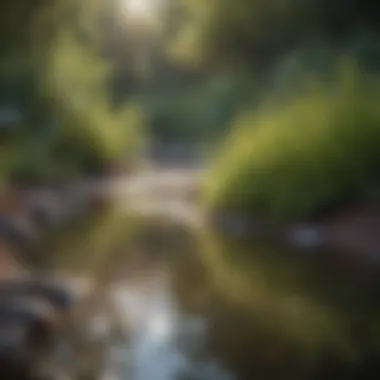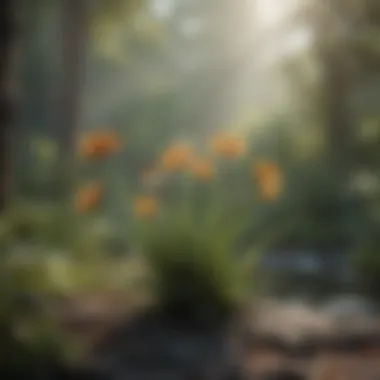Revitalizing Landscapes: Embracing Native Plants for Sustainable Transformation


Overview of the Topic
In the exploration of revitalizing landscapes, shifting from conventional grass lawns to native plants stands out as a significant endeavor. The importance of this transformation lies in its ecological advantages, water conservation benefits, and aesthetic enhancements. By opting for native plant landscaping, individuals can not only enhance the natural ecosystem but also contribute to sustainable practices. Understanding the selection of suitable native species alongside effective maintenance tips is pivotal in fostering positive environmental change through personalized landscaping choices.
Current Status and Challenges
Currently, the prevalence of traditional grass lawns dominates residential and commercial landscapes, posing challenges to biodiversity and resource conservation. The maintenance requirements, including frequent watering and pesticide use, contribute to environmental degradation. The scarcity of water resources further underlines the need to address unsustainable landscaping practices, urging a shift towards more eco-friendly alternatives. Challenges also surface in the form of landscape design perceptions and community norms that prioritize manicured grass lawns over native plant diversity.
Sustainable Solutions
To overcome the challenges posed by conventional landscaping practices, adopting sustainable solutions centered around native plants emerges as a transformative approach. This shift not only reduces water consumption but also promotes biodiversity and enhances local ecosystem resilience. By incorporating native species into landscapes, individuals can create habitat corridors for wildlife, improve soil health, and reduce reliance on chemical inputs. Successful case studies spotlight the effectiveness of integrating native plants into landscapes, showcasing the positive environmental impact and long-term sustainability of such practices.
Impact and Importance
The impact of transitioning from grass to native plants reverberates across ecosystems, communities, and future generations. This holistic approach to landscaping results in improved soil retention, increased pollination activity, and enhanced water filtration capacities. The significance of conservation efforts and sustainable resource use shines through in the positive influence on local flora and fauna. Emphasizing the importance of preserving native plant species underscores the fundamental role they play in ecosystem balance, community well-being, and fostering a harmonious coexistence between humans and nature.
Introduction
In the realm of landscaping, a paradigm shift is underway - a movement towards replacing conventional grass lawns with vibrant native plants is gaining momentum. This transition from the familiar green carpets to ecologically beneficial plant species heralds a new era of sustainable landscaping practices. This article serves as an illuminating guide, shedding light on the myriad advantages and considerations involved in this transformation from grass to native plants.
Significance of the Topic
The conversion from grass to native plants is not merely a superficial alteration but a substantial step towards environmental stewardship. By shifting away from resource-intensive grass lawns to native plant landscapes, individuals can contribute significantly to biodiversity preservation, water conservation, and ecosystem restoration. This transition holds immense ecological importance, fostering resilience in local flora and fauna and mitigating the detrimental effects of monoculture lawns on the environment.
Relevance and Benefits


Understanding the pivotal role of native plants in promoting biodiversity, enhancing soil health, and attracting pollinators underscores the significance of this topic. By delving into the ecological underpinnings, water-saving merits, and aesthetic allure of native landscapes, individuals can grasp the multifaceted benefits awaiting them. This article aims to unravel the intricate tapestry of advantages tied to incorporating native flora into landscaping, encouraging a conscientious approach towards sustainable land management.
Considerations for Transition
Embarking on the journey from grass to native plants necessitates careful deliberation and strategic planning. Factors such as researching local species, assessing soil compatibility, and nurturing a diverse plant palette emerge as critical considerations. By navigating through these pivotal aspects, readers can equip themselves with the knowledge and insight required to undertake this transformative endeavor successfully.
Understanding Native Plants
Understanding native plants is fundamental when considering landscaping transformations from traditional grass to native species. In this article, we delve deep into the importance of incorporating native plants, emphasizing their ecological significance, local environmental adaptability, and biodiversity support. Native plants play a vital role in maintaining ecosystem balance and preserving native flora and fauna. By understanding their unique characteristics and benefits, individuals can make informed decisions that positively impact the environment.
Ecological Importance
The ecological importance of native plants lies in their ability to support local ecosystems sustainably. Unlike non-native species, native plants have co-evolved with the environment, forming crucial relationships with native wildlife. They provide habitat and food for various insects, birds, and mammals, contributing to ecological diversity. Additionally, native plants require fewer pesticides and fertilizers, promoting a healthier ecosystem overall.
Adaptability to Local Environment
Native plants demonstrate exceptional adaptability to local environmental conditions, making them well-suited for landscaping projects. Due to their evolutionary history in specific regions, they are more resilient to local pests, diseases, and climate variations. This adaptability reduces the need for excessive maintenance and promotes long-term sustainability in landscaping practices.
Biodiversity Support
Another key aspect of native plants is their role in supporting biodiversity. By planting a diverse array of native species, individuals can create mini-ecosystems within their landscapes. This diversity attracts a wide range of pollinators, beneficial insects, and wildlife, enhancing the overall biodiversity of the area. In turn, a biodiverse landscape is more resilient to environmental changes and provides numerous ecological benefits.
Benefits of Replacing Grass with Native Plants
Native plants play a pivotal role in fostering biodiversity and environmental stability. Unlike the homogeneous nature of grass lawns, native plants support a rich tapestry of native fauna, ranging from birds to insects. This intricate web of biodiversity helps in maintaining a sustainable ecosystem while enhancing the aesthetic appeal of the landscape. Furthermore, the deep-rooted nature of many native plants aids in preventing soil erosion, thereby fortifying the land against degradation.
When considering the aspect of water conservation, the transition to native plants emerges as a cornerstone of sustainable landscaping. Native flora is inherently adapted to local climatic conditions, requiring minimal irrigation once established. This innate adaptability not only reduces water consumption but also lessens the dependency on artificial irrigation systems, consequently diminishing the carbon footprint associated with traditional lawn maintenance.


Pollinator Support within the ecosystem is another critical aspect amplified by incorporating native plants. By providing nectar, pollen, and shelter to native pollinators such as bees and butterflies, these plants bolster the intricate web of pollination crucial for agricultural productivity and natural balance. The symbiotic relationship between native plants and pollinators solidifies the ecosystem's resilience and vitality.
Moreover, the allure of reduced maintenance bestowed by native plant landscapes cannot be overstated. Unlike the high upkeep demanded by manicured grass lawns, native plantings are inherently low-maintenance once established. By obviating the need for frequent mowing, fertilization, and pesticide application, individuals not only save on time and effort but also contribute to curbing environmental pollution associated with chemical inputs.
Selecting Native Plants
Researching Local Species
Delving into the realm of Researching Local Species unveils a layer of crucial information essential for selecting the most suitable plant varieties for a particular region. This aspect involves studying the native flora indigenous to the area, understanding their growth patterns, habitat requirements, and interactions with other species. Through in-depth research, individuals can uncover unique plant species that not only enhance the aesthetics of the landscape but also promote biodiversity and ecological balance. By considering factors such as native species' role in supporting local pollinators and wildlife, the selection process becomes a strategic endeavor aimed at fostering a harmonious coexistence between plants and their surroundings.
Suitability to Soil and Climate
The aspect of Suitability to Soil and Climate emphasizes the importance of aligning chosen native plants with the specific soil compositions and climatic conditions of the landscaping site. Different plant species have varying requirements concerning soil type, pH levels, drainage, and sunlight exposure. By evaluating these factors and ensuring the selected plants are well-suited to the prevailing climate patterns, individuals can establish a resilient and thriving ecosystem within their landscape. Understanding the complex interplay between soil health, microclimates, and plant adaptations is key to creating a sustainable and biodiverse plant palette that flourishes in its natural environment.
Creating a Diverse Plant Palette
Creating a Diverse Plant Palette involves curating a collection of native plant species that not only complement each other aesthetically but also serve diverse ecological functions within the landscape. By integrating plants with different heights, textures, flowering periods, and growth habits, individuals can establish a dynamic and visually engaging ecosystem. A diverse plant palette not only enhances the visual appeal of the landscape but also fosters resilience against pests, diseases, and environmental stressors. By selecting a thoughtful mix of plants that fulfill various ecological roles such as nitrogen fixation, soil stabilization, and wildlife habitat provision, individuals can ensure the long-term health and sustainability of their landscaped areas.
Transforming Your Landscape
Transforming Your Landscape section delves deep into the pivotal shift from conventional grass lawns to vibrant native plant landscaping. This transformation is not just about visual aesthetics but embraces ecological sustainability and water conservation earnestly. By meticulously replacing grass with native plant species, individuals can embark on a journey towards fostering biodiversity and minimizing environmental impact. Creating a harmonious blend of native flora in one's landscape holds the promise of a healthier ecosystem and a more resilient habitat for various wildlife.
Removal of Grass
In the process of transitioning from grass to native plants, the initial step involves the removal of existing grass patches meticulously. This phase demands attention to detail to ensure that the grass is entirely eradicated, preventing any resurgence. Various methods such as sheet mulching or solarization can be employed to effectively eliminate the grass without compromising soil integrity. By eradicating grass and its shallow root system, space and nutrients are freed up for the forthcoming native plantings, facilitating their robust growth and establishment.
Preparing the Soil


Preparing the soil post-grass removal is a critical step that sets the foundation for successful native plant establishment. Soil preparation involves assessing soil quality, enhancing its fertility, and improving drainage to create an optimal growing environment for native plants. Techniques like soil testing, compost incorporation, and mulching aid in fortifying the soil structure, ensuring that it can adequately support the growth and development of the selected native species. A well-prepared soil bed is essential for nurturing healthy plants and encouraging strong root systems.
Planting and Maintenance
The process of planting native species signifies the commencement of a sustainable landscape transformation. When planting, factors such as species compatibility, spacing, and seasonal considerations must be taken into account to promote plant vitality and biodiversity. Regular maintenance practices including watering, weeding, and trimming are fundamental to foster plant health and ensure their longevity. Monitoring plant growth, addressing any signs of stress, and adapting maintenance routines as per seasonal variations are integral aspects of sustaining a thriving native plant landscape. By adhering to diligent maintenance protocols, individuals can nurture flourishing native plant communities and reap the ecological rewards of their landscape transformation.
Tips for Successful Transition
Revitalizing your landscape from traditional grass to native plants is a meticulous process that requires careful planning and execution for a successful transition. Tips for successful transition play a pivotal role in ensuring that your landscaping project yields optimal results while benefiting the environment. One key element to consider is the gradual replacement of grass with native plants instead of a sudden overhaul, allowing for smoother adaptation of both flora and fauna to the new ecosystem. This gradual implementation minimizes shock to the existing ecosystem, fostering biodiversity and sustainability over time. Another crucial aspect is monitoring plant health regularly to identify any issues promptly. By closely observing the growth, vigor, and interactions of native species, you can intervene effectively if problems arise, safeguarding the health and stability of your landscape. Seeking expert advice is equally essential in navigating the complexities of transitioning to native plants. Consulting with professionals, such as ecologists or landscaping experts, can provide valuable insights and recommendations tailored to your specific environment and goals. Their expertise can enhance the success of your project and address any challenges that may arise, ensuring a seamless and thriving transformation.
Gradual Implementation
Gradual implementation is a fundamental strategy when transitioning from grass to native plants. This approach allows for a smoother adjustment period for both the landscape and its inhabitants. By gradually introducing native species into the existing grass lawn, you promote ecological diversity and resilience. This method also reduces the risk of plant shock and allows wildlife to adapt to the changing habitat gradually. As the native plants establish themselves, they create a self-sustaining ecosystem that requires minimal intervention while supporting local biodiversity. Gradual implementation fosters the long-term health and stability of the landscape, promoting sustainable practices and environmental conservation.
Monitoring Plant Health
Monitoring plant health is vital in ensuring the success of your transition to native plants. Regularly observing the condition of your plants allows you to detect early signs of stress, disease, or nutrient deficiencies. By promptly addressing these issues, you can prevent them from spreading and optimize the growth and vitality of your native plants. Monitoring plant health also involves assessing factors such as soil quality, moisture levels, and sunlight exposure to provide the optimal conditions for plant growth. Through vigilant observation and proactive care, you can maintain a flourishing native plant landscape that sustains biodiversity and ecosystem health.
Seeking Expert Advice
Seeking expert advice is a prudent step in the process of revitalizing landscapes with native plants. Experts bring specialized knowledge and experience that can enhance the success of your landscaping project. By consulting with professionals familiar with local ecosystems, soil conditions, and plant species, you can make informed decisions and avoid potential pitfalls. Experts can provide valuable guidance on selecting the right native species, preparing the soil, and ongoing maintenance practices tailored to your specific landscape. Their insights can help you navigate challenges effectively, optimize plant health, and create a thriving native plant oasis that benefits both the environment and the surrounding ecosystem.
Conclusion
In the landscape design realm, the Conclusion segment serves as the pivotal point of reflection and consolidation. Within this intricate landscape metamorphosis from grass to native plants lies a profound symbolism embedded with ecological and sustainability virtues. The crux of this transformative narrative not only encapsulates a mere botanic alteration but unveils a saga of environmental stewardship and conscientious landscaping practices reshaping the very fabric of urban aesthetics.
Adopting a paradigm shift from traditional grass lawns to native plant marvels symbolizes a dynamic shift towards sustainable landscaping practices. The case for this evolutionary transition is multifaceted, resonating with a broader agenda of ecological conservation, water sustainability, and biodiversity promotion. As landscapes transcend beyond mere visual appeal to becoming active participants in ecological restoration, native plants emerge as crusaders of this essential transformation.
Delving deeper, the importance of this Conclusion segment extends far beyond upgrading the physical landscapes. It unveils a narrative writ with intricate ecological dialogues, where the symbiotic relationship between native flora and fauna orchestrates a harmonious symphony of biodiversity and ecosystem resilience. By delving into the core essence of native plant integration, individuals embrace a form of environmental activism through their landscaping choices, fostering habitats for pollinators, fueling water conservation efforts, and championing the propagation of indigenous botanical heritage.
Furthermore, in the broader spectrum of ecological discourse, the Conclusion acts as a beacon of enlightenment, illuminating pathways for individuals to embark on a journey of sustainable citizenship. As individuals tread on the trail of defying conventional landscaping norms and embracing the verdant allure of native plant species, they tread upon a narrative thread intertwined with environmental consciousness, resonating with the ethos of ecological empathy and stewardship.
Navigating through this transformative landscaping odyssey provides a lens not only for individual enlightenment but sparks a collective movement towards greener urban landscapes. The Conclusion of this reverie embodies the essence of a multifaceted narrative, highlighting the intrinsic values of embracing change, championing sustainability, and sculpting landscapes that breathe life into the ecological ethos of the modern era.



